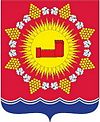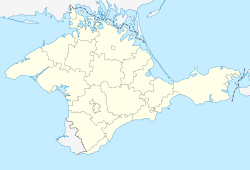Sudak
|
Sudak Судак Sudaq |
|||
|---|---|---|---|
| City | |||

The Sudak Bay in the evening.
|
|||
|
|||
| Location of Sudak (red dot) within Crimea | |||
| Coordinates: 44°51′5″N 34°58′21″E / 44.85139°N 34.97250°ECoordinates: 44°51′5″N 34°58′21″E / 44.85139°N 34.97250°E | |||
| Country | Russia/Ukraine | ||
| Republic | Crimea | ||
| Municipality | Sudak Municipality | ||
| Government | |||
| • Mayor | Vladimir Serov | ||
| Elevation | 50 m (160 ft) | ||
| Population (2014) | |||
| • Total | 16,492 | ||
| Time zone | MSK (UTC+3) | ||
| Postal code | 98000 — 98015 | ||
| Area code(s) | +7-36566 | ||
| Former names | Soldaia (until 1475), Sougdeia, Sidagios | ||
| Climate | Cfa | ||
Sudak (Ukrainian: Судак; Russian: Судак; Crimean Tatar: Sudaq; Greek: Σουγδαία; sometimes spelled Sudac or Sudagh) is a town, multiple former Eastern Orthodox bishopric and Latin Catholic titular see of regional significance in Crimea, a territory recognized by most countries as part of Ukraine but annexed by Russia as the Republic of Crimea. Sudak serves as the administrative center of Sudak Municipality, one of the regions Crimea is divided into. It is situated 57 km (35 mi) to the west of Feodosia (the nearest railway station) and 104 km (65 mi) to the east of Simferopol, the republic's capital. Population: 16,492 (2014 Census).
A city of antiquity, today it is a popular resort, best known for its Genoese fortress, the best preserved on the northern shore of the Black Sea.
It is believed that the city was founded in 212 CE by Alani settlers on the territory of the Bosporan Kingdom. Merchants from the Roman Empire founded Sougdaea, in Greek Σουγδαία (a reference to Sogdia) in the 3rd century. In the 6th century, the Eastern Roman Emperor Justinian I ordered the construction of a fortress. The Khazars attacked in the 7th century, giving it the name Suğdaq. The Life of St. Stefan of Surozh (Russian: св. Стефан Сурожский) describes the 8th-century town as a dependency of the Byzantine Empire. Around the start of the 9th century, it was supposedly attacked by the Rus' chieftain, Bravlin. It is thought that the Khazars retained the town from the early 9th century until 1016, when the Byzantines finally defeated the Khazar warlord Georgeios Tsulo. Afterwards, the town seems to have preserved some sort of autonomy within the Byzantine Empire.
...
Wikipedia



